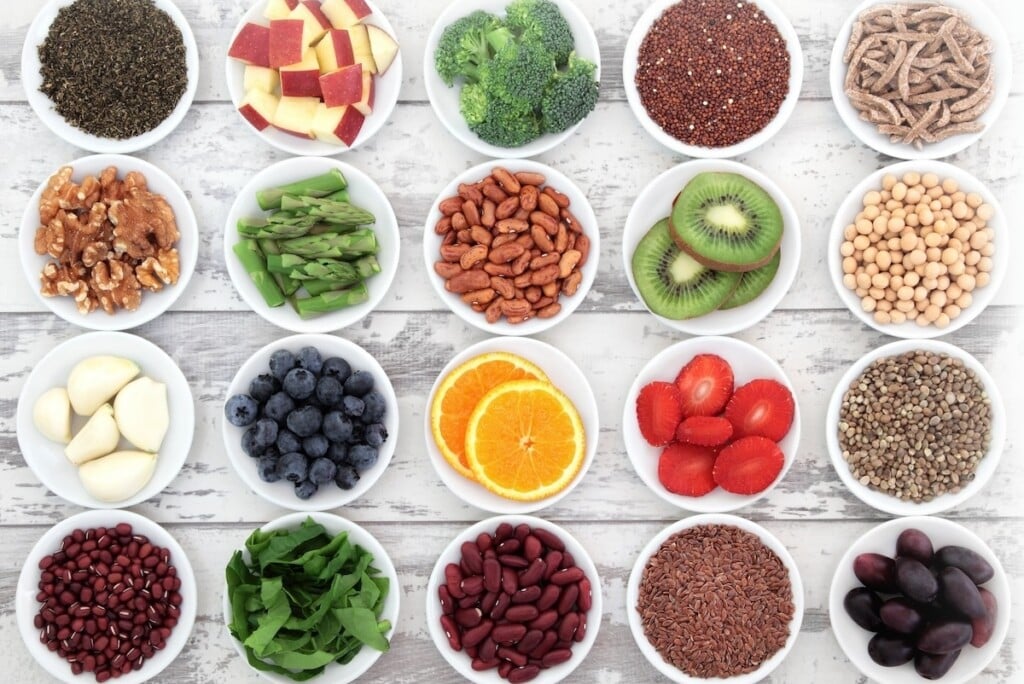15 ‘Super’ Things to Eat
No one “superfood” guarantees good health, but this honor roll of nutritious edibles can help put you on the path.

These days, trendy “superfoods” are said to do everything from decreasing inflammation to improving digestion. “But that’s a catchy marketing term rather than a scientific one,” warns Lauren Torrisi-Gorra, a registered dietitian-nutritionist who owns Forme Nutrition in Franklin Lakes.
People—or companies—use the word “superfood” to describe “something rich in nutrients, bioactive compounds or antioxidants that may offer some health benefits beyond basic nutrition,” she explains. “But it’s important to remember that no single food can fix a poor diet. Health comes from consistently eating a variety of whole foods.”
None of the 15 foods below is a panacea you can simply gobble to ward off all ills. But each has earned a place in your grocery basket with qualities that, yes, you could call “super”:
- AVOCADOS. Technically a fruit, the avocado is usually categorized as a healthy, unsaturated fat. “It supplies fiber, potassium and monounsaturated fats that support heart health,” says Torrisi-Gorra. “Spread on toast, dice into salads or enjoy as a snack sprinkled with sunflower seeds.” Avocados mashed into guacamole are also nutritionally sound, particularly when homemade.
- BERRIES. The world of berries varies, from the sweet and subtle blueberry to the tart raspberry, but one thing’s consistent: “Berries are high in antioxidants and vitamin C, protecting blood vessels and reducing oxidative stress,” she says. Oxidative stress occurs when you don’t have enough antioxidants in your body; it can lead to cell damage. She suggests you “wash berries as soon as you bring them home from the store—they’ll be ready to sprinkle on oatmeal or yogurt.”
- CHOCOLATE, DARK. Here’s an indulgence you can feel good about. “Dark chocolate that is 70 percent cocoa or higher contains flavanols, which are antioxidants that improve blood-vessel function and may enhance cognition,” says Torrisi-Gorra. “Enjoy one or two ounces to best reap the benefits.” Eat it on its own or melt it down and dip something into it—perhaps one of the berries mentioned above, for a one-two punch of after-dinner antioxidants.
- EGGS. Says our expert: “Eggs are a source of choline, a nutrient essential for brain function and memory, plus high-quality protein with all essential amino acids. And most of the nutrition is in the yolk—don’t skip it!” Though in the past we’ve been warned away from heavy consumption of this breakfast favorite because of its high cholesterol content, recent research indicates that eating one egg a day does not increase the risk of heart attacks, strokes or other cardiovascular diseases.
- FISH. A great source of protein and a staple in the famous Mediterranean diet, proven to lower heart disease risk, “fatty fish, such as salmon and sardines, deliver omega-3s that support heart and brain health and may even promote brain-cell growth,” she says. “Aim for two to three servings a week, choosing what we call SMASH fish—salmon, mackerel, anchovies, sardines and herring—and look for sustainable sources.”
- GRAINS, WHOLE. “Replacing refined grains with whole versions is one of the easiest health swaps you can make,” she says. Refined grains include white bread, pasta and white rice. As the name suggests, the grain has been processed to remove most parts of the kernel, including the bran, germ and endosperm—which contain the nutrients you don’t want to skip out on. “Whole grains like oats, quinoa and brown rice deliver fiber and B vitamins that support digestion and lower heart disease risk,” she adds.
- GREENS, DARK AND LEAFY. “Greens like spinach, kale and Swiss chard are packed with fiber, folate and antioxidants that help reduce cancer and chronic-disease risk,” says Torrisi-Gorra. “If you’re not a fan of the taste, blending a handful into a smoothie masks the flavor.”
- LEGUMES. This category includes peas and all kinds of beans, and she sings their praises. “Beans, lentils and chickpeas deliver resistant starch, a fiber that feeds gut bacteria and improves blood-sugar control,” she explains. “One cup can provide about a third of your daily fiber.” Legumes are a low-cal way to feel full, and also a great source of plant based protein for vegetarians and vegans.
- MUSHROOMS. Lauded for the deep umami flavor they can add to dishes, mushrooms can also lend a nutritional punch. “They provide antioxidants and immune-supporting compounds, plus they’re one of the few plant sources of vitamin D,” she says. Vitamin D is essential for bone health, and with calcium can help protect older adults against osteoporosis, per the National Institutes of Health. She recommends that you “keep frozen mushrooms on hand to toss into stir-fries or soups.
- NUTS. Snack time is saved with these quick, healthy bites. “Rich in heart-healthy fats, plant protein and antioxidants, nuts have been linked to a lower risk of cardiovascular disease when eaten regularly,” she says. “Almonds, walnuts and pistachios are some of the best choices—a handful makes an easy, on-the-go snack.” Avoid sugary trail mixes and “honey-roasted” options, which often add in a lot of calories, and opt for something lightly salted. You can also toss some into a salad for an added crunchy bite.
- POMEGRANATES. “These fruits are rich in punicalagins, which are polyphenols [a specific compound found in plants] with strong anti-inflammatory and heart-protective effects,” explains our expert. She suggests you “sprinkle seeds on yogurt or salads for a sweet crunch.” Don’t have time to cut one open and coax the seeds out yourself? Many health-food stores offer containers with only the seeds, ready to eat.
- SWEET POTATOES. Says Torrisi-Gorra: “Sweet potatoes are rich in beta-carotene, fiber and potassium, which support eye and metabolic health.” These root vegetables are a source of unrefined and unprocessed carbohydrates. All carbohydrates break down into sugar, but when unrefined they also include fiber and those other essential nutrients. For that reason, she adds, “despite their sweet taste, sweet potatoes have a gentler effect on blood sugar than refined carbs.”
- TOMATOES. Also front and center in the Mediterranean diet (and a staple in backyard vegetable gardens), “tomatoes are rich in lycopene, a powerful antioxidant that supports heart health and reduces cancer risk,” she says. Preparation matters too, of course, and Italian-food enthusiasts in the audience will rejoice over her next tip: “Cooking them with olive oil boosts nutrient absorption.”
- VEGETABLES, CRUCIFEROUS. OK, maybe you dissed these foods as a kid, but now you can put away childish prejudices. “Broccoli, Brussels sprouts and cauliflower contain glucosinolates, which break down into sulforaphane—a compound that protects DNA and lowers cancer risk,” she explains. “Light steaming or roasting helps preserve nutrients.” Also in this family is bok choy, an easy way to upgrade a stir-fry.
- YOGURT. This food is “a great source of protein, calcium and probiotics that benefits both gut and bone health,” says our expert. Greek yogurt is especially high in protein—one six-ounce serving can contain 15 to 17 grams of it. “Check labels and keep sugar under 10 grams per serving,” particularly for yogurt that adds in fruit and other flavorings. (Pro tip: Use Greek yogurt instead of sour cream when topping baked potatoes or chili for the creaminess without the calories.)

